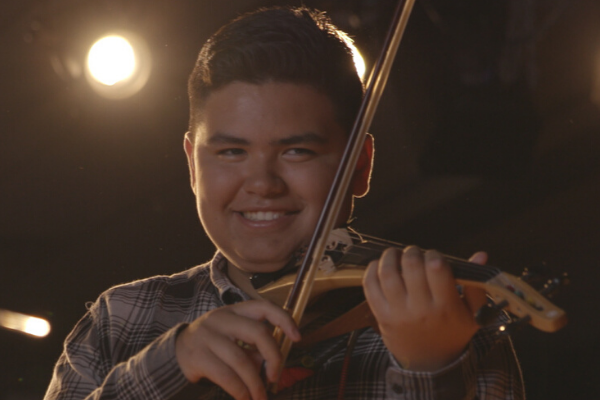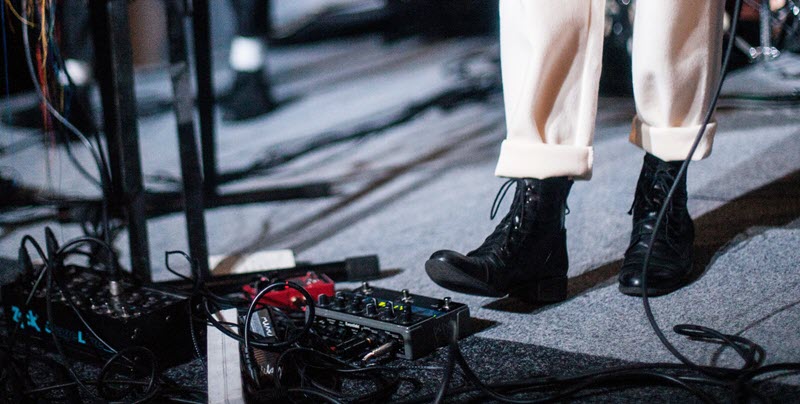Tagged Under:
Going Electric
Five reasons why today’s orchestral string instruments aren’t always acoustic.
Acoustic string instruments are largely accredited to the 17th century designs of the Amati, Stradivari and Guarneri schools — a period known as the “Golden Age” of violin making. But the instruments didn’t stop evolving at that point. They changed — and continue to change — to meet the demands of players, composers and listeners. Today we live in a new golden age: that of electric string instruments.
Electric violins, violas, cellos and basses are not as new as you might think. There are electric violin designs that date back to the 1920s, though they didn’t gain widespread popularity until the 1970s, when the burgeoning jazz-fusion genre began to incorporate new sounds. The electric cello and electric upright bass were both invented in the 1930s; the electric viola in the 1950s. And all are commonly employed by musicians today, in musical genres of every stripe and variety.
Let’s take a look at some of the reasons why acoustic string instruments have evolved into their electric counterparts over the years, and why electric strings continue to grow in popularity.
1. Modern Ensembles
With the rise of rock and roll in the 1950s, the big bands that predominated popular music in the first half of the 20th century gave way to small ensembles centered around electric guitar and electric bass, along with drums. In the second half of the century, electric keyboards and synthesizers were added. Acoustic instruments like violin, viola, cello and bass simply couldn’t compete with the high volume of the other instruments being played. It was inevitable that these string instruments needed to evolve into electric versions, just as guitars and keyboards had done previously.
2. Modern Venues
For hundreds of years, performing venues have been evolving too — from the ballrooms of the 14th century to the great opera houses of the 18th and 19th century, all the way to the huge modern sports arenas that host major music performances today. This growing size was initially addressed by adding more players to meet the volume level necessary so that attendees could hear the music being performed: Quartets became chamber groups; chamber groups became large symphonic orchestras.
But acoustic string instruments needed to evolve over that time, too, and so metal strings were developed to produce more volume. But the force of metal strings was more than the older instrument designs could bear, and the increased pressure on the top of the instrument caused many of them to collapse. Necks were then made longer to reduce the pressure of the metal strings on the body, and makers redesigned the dimension of the bass bar — a long narrow piece of spruce inside the top, on the bass side. This not only increased the volume of the instrument, but also made it possible for players to perform the wider range of melodic passages being written by composers.
Still, as venue size increased to the point where it is today — with ensembles often performing to hundreds, thousands, or even tens of thousands of attendees — metal strings and acoustic instrument redesigns were simply not enough. It was clear that electric versions of traditional acoustic string instruments had to be created.
3. Modern Styles
For centuries, orchestral instruments were restricted to the confines of baroque, classical, renaissance and modern orchestral styles of music composition. That changed in the 1970s when violinists started to take their cues from electric guitarists. Players put down their acoustic instruments and began to experiment with electric versions. While one important reason was to compete with the volume of other electric instruments in the group, another reason was that the sound of these new instruments could be processed through effects pedals, like an electric guitar. All of a sudden, a violin could not only sound like a violin, it could sound like an electric guitar. This opened a whole new world of sonic possibilities to string performers so that today, you’ll hear electric strings being used in every style of music.
4. Modern Technologies
The ever-accelerating advancement of new technologies has increased the ability of electric strings to keep up with newer styles of music. Better pickup systems, along with the arrival of solid-state technologies in the 1950s, gave the electric instruments of the era a clean, strong signal. But early electric string designs were mostly solid-body — more like electric guitars and not acoustic-sounding enough to satisfy many players and listeners. These instruments were also uncomfortably heavy, making it difficult for most performers to bear their weight over the course of a performance that might run several hours.
To overcome these limitations, electric string manufacturers sought out new materials such as fiberglass, carbon fiber and Lucite. These stronger and lighter materials brought instrument weights down considerably and allowed for the addition of resonation chambers that gave electric instruments sonic properties that were much closer to the original acoustic instruments. What’s more, the new finishes and colors that could be applied made these instruments more visually appealing — players could even add beads and crystals to the body to personalize the instrument, much like the original acoustic designs where the distinct flaming of the wood materials gave each player the ability to know exactly which instrument was theirs. Today’s LED technology even makes it possible for some electric string instruments to light up in different colors as they’re being played!
Another feature that appeals to many players is the ability to play electric string instruments silently through headphones. This is great for students who need to practice at home without disturbing family members or neighbors, as well as for touring professionals who have to do their practicing on a tour bus or in a hotel room. As one high-profile touring violinist has said, “When I practice, I practice the things I don’t play well. The last thing I want is someone walking past my hotel room and hearing me sound bad.”
5. Modern Economics
An important byproduct of technical development is its impact on price. As technology became more readily available, manufacturing techniques became more efficient. In turn, as the resulting electric string instruments became better-sounding and better-looking, the demand for them increased, which served to bring the cost down. Today, there is an electric string instrument for every budget. Schools can afford to incorporate electric ensembles into their traditional orchestral programs, and educators have been able to use the popularity of electric string instruments to recruit new students and retain them as they enjoy playing the popular music they listen to every day.

New designs by modern instrument makers continue to give performers the tools they need to meet the demands of modern music and most importantly, we listeners. Modern orchestral string players are quickly realizing that, in addition to their acoustic instrument, they also need an electric version, for both performance and recording. For them, and for us, it’s like having the best of both worlds!
Check out these related blog articles:
SILENT™ and Electric String Instruments, Explained
How to Choose the Best Amplifier for Your Electric String Instrument
How to Silently Practice Your String Instrument at Home
How to Select an Electric Upright Bass
Electric Strings: The Power of Plugging In
Click here for more information about Yamaha electric string instruments.















